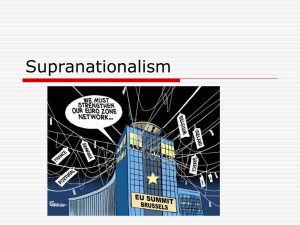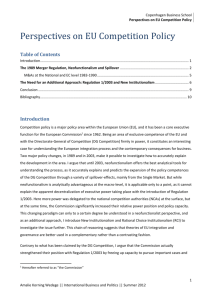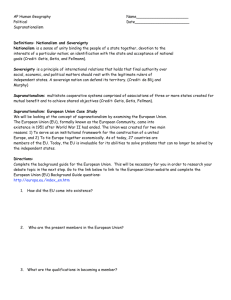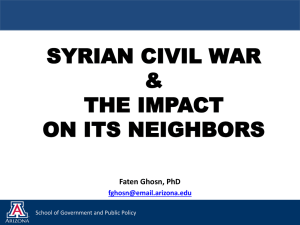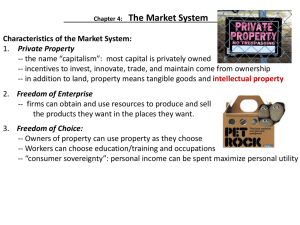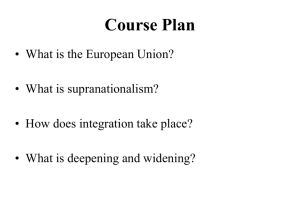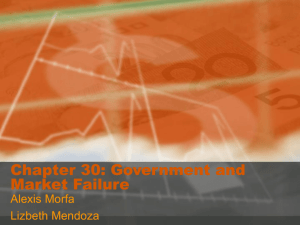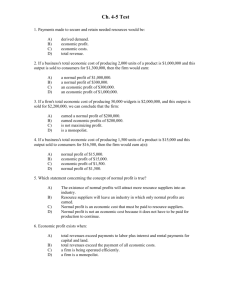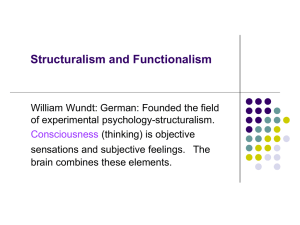Why states choose integration
advertisement
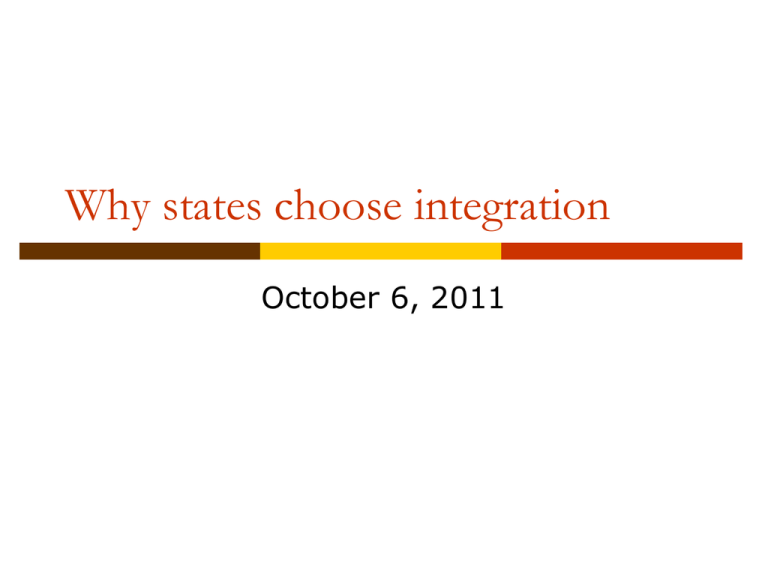
Why states choose integration October 6, 2011 What is the European Union? International Organization No autonomous powers No authority to impose its rulings on its members Federation European Union Voluntary integration among sovereign states EU inst. make laws and policies binding on the MS What is integration? Integration: sharing and pooling sovereignty vs. transfer or delegation of sovereignty and supranationalism Integration: “process by which political leaders and citizens in separate countries create new common governing institutions, giving these institutions jurisdictional powers and shift some of their loyalties and expectations to that new level of government (McCormick, 2002, p. 13) Separate individual decisions vs. joint decisions OR delegate decisions to new institutions What is supranationalism? Supranationalism: “a process by which national governments share sovereignty with transnational institutions whose laws and policies are binding on those governments” majority voting by national representatives in order to make decisions executive authority and parliamentary body independent of national control independent court whose jurisprudence is binding at the national level, level of member states Levels of Integration 1- General liberalization of tariff and quotas (GATT/WTO). 2- Free Trade Areas: removal of tariffs, quotas and NTBs (NAFTA, Israel-Turkey etc..) 3- Customs Union: FTA + Common External Tariffs (Free movement of goods). 4- Common Market: Fully integrated market with four freedoms, free movement of goods, capital, people and services, extensive harmonization of laws. 5- Economic/Monetary Union (common fiscal and monetary policies with common currency) 6- Political Union ? How to explain European integration: theories of integration Theorizing about “explaining integration” vs. “analyzing governance” and “constructing the EU” in T. Diez and A. Wiener, “Introducing the mosaic of integration theory” in Wiener and Diez, eds., European integration theory (Oxford University Press, 2004). Early theorizing on European Integration Functionalism Mitrany (1943), Excerpts in Nelsen and Stubb. Boulder: Lynne Rienner. 99-119. Break away from the link between authority and territory international cooperation on functionally specific fields More efficient provision Help transfer loyalties to int’l level Evolution of cooperation Functionalism in practice Jean Monnet Preoccupation with the technical and noncontroversial issues Institutions Functionalism in Practice: R. Schuman The Schuman Declaration (1950) “Europe will not be made all at once or according to a single plan. It will be built through concrete achievements which first create a de facto solidarity” Theorizing on European Integration Functionalism Critique: Linear and automatic integration? No theory of politics Neofunctionalism: E. H aas, The Uniting of Europe (1968) also excerpts reprinted in elsen and Stubb. 2003. The European Union: Readings on the Theory and Practice of European Integration, Boulder: Lynne Rienner. pp. 145-9.; P. Schmitter, “Three NeoFunctional Hypothesis about international integration” International Organization, Vol. 23, Neofunctionalism 1) Clarified the dependent variable (the outcome to be explained) 2) Clarified the concept of “spillover” 3) Attempted to develop a theory of politics and to insert political agency - Spillover - Institutions 4) Scientific study of the phenomena of regional integration Political integration “the process whereby political actors in several distinct national settings are persuaded to shift their loyalties, expectations and political activities toward a new center, whose institutions possess or demand jurisdiction over the preexisting national states. The end result of a process of political integration is a new political community, superimposed over the preexisting ones” The background conditions - Pluralistic social structure - High level of economic and industrial development - Ideological homogeneity Given the background conditions, how does integration happen? 1. The Concept of Spillover Main mechanism of change Spillover refers to a situation in which a given action creates a situation in which the original goal can be assured only by taking further action.. Functional (from sector to sector), political (support for further integration/barrier to retreat) and cultivated spillover (Commission fosters pressure groups/interests i.e. Erasmus) Some sectors have more integrative potential 2. Interest Groups Political parties, interest groups (UNICE, ETUC) Supranational orientation Transnational cooperation to achieve common goals 3. Supranational Institutions Significance of supranational institutions and their leaders “Elite socialization” Working with supranationally-oriented interests Neofunctionalism, evolution Initial success of neofunctionalism (From ECSC to EEC & beyond) Slow pace of integration, de Gaulle & nationalism Revived again in the 1990s De-emphasized spillover, emphasized institutions Critiques of Neofunctionalism Slow pace of integration (mid 60s- mid 80s) States still important No elite socialization International context of regional integration Theory of regional integration OR empirical generalization? Intergovernmentalism Basic literature: S. Hoffman, “Obstinate or Obsolete? The Fate of the Nation-State and the case of Western Europe” Deadalus, Vol. 95, 1966, pp. 862-915 and The European Sisyphus: Essays on Europe, 1964-1995 (Boulder, 1995). Reaction to the “empty chair crisis” June 1965 – January 1966 provoked by Charles de Gaulle and resolved with the “Luxembourg Compromise” calling for unanimity decision making at the Council. Main Features I Organized interest vs. political calculations: integration only possible when governments want it and suit their interest Governments uniquely powerful actors and determine integration by national interest Where national interests coincide closer cooperation but not in the area of “high politics” Main Features II Governments can not be overwhelmed by pressure groups to integrate but political calculations matter most: - impact of integration on economy - electoral performance of party in government interest groups may influence low politics but only influence ultimate arbiter government because: - posses legal sovereignty - political legitimacy Liberal Intergovernmentalism Basic literature: A. Moravcsik, The Choice for Europe (Cornell University Press, 1998) and “Preferences and Power in the EC” JCMS, Vol. 31, No. 4, 1993. Reaction to the Treaty on the European Union. Main Features the notion of two level games domestic political processes determine national interest (balance of interests within a state) reconciliation of national interests at the table of Council of Ministers: - 1st – reach agreement on common policy response to problem to be solved - 2nd – reach agreement on appropriate arrangement e.g. treaties etc… Hence major choice of integration reflection of preferences of national governments not preferences of supranational considerations national preferences balance of economic interests rather than political biases of politicians or national strategic concerns outcomes a function of - relative bargaining, - prevent defection rather than federalist agenda
